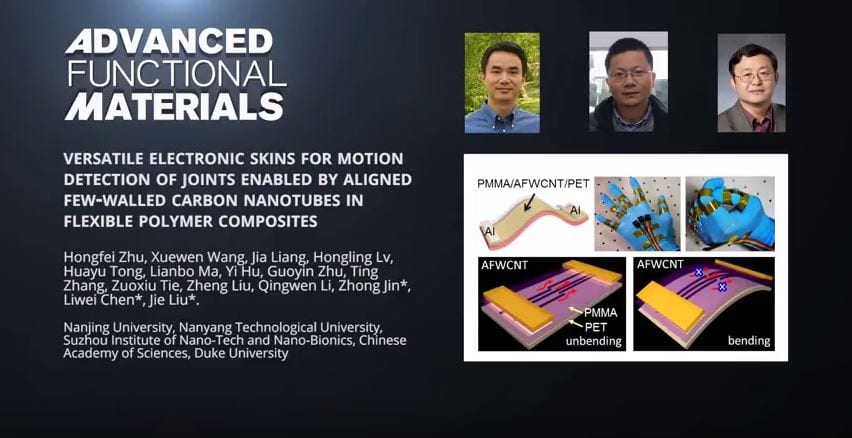The human skin is an organ with amazing sensory properties. It can pick up a variety of sensations from its environment. Mimicking those properties in wearable electronics skins would offer a variety of applications for human–machine communication— imagine if you could fly a helicopter by simply moving your hand—and motion detection.
In their publication in Advanced Functional Materials, Liwei Chen from the Chinese Academy of Sciences, Zhong Jin from NanJing University, Jie Liu from NanJing University and Duke University, and their co-workers, present a new type of piezoresistive electronic skin (or E‑skin). Their design is based on aligned few-walled carbon nanotube polymer composites, which allows for flexion detection, in contrast to devices applying randomly dispersed carbon nanotubes.
Arrays of aligned few-walled carbon nanotubes are paved on a polyethylene terephthalate (PET) substrate. Subsequent spin-coating with poly(methyl methacrylate) (PMMA) yields a smooth but conductive surface, ready for electrode attachment. Upon bending, the device exhibits Ohmic behavior, which changes with the bending angle according to a linear, highly reproducible relationship. This amazing performance is maintained for at least 15 000 bending cycles, demonstrating the durability of the device.
Arrays without polymer coating are less responsive to bending, while devices based on conventional randomly dispersed carbon nanotubes do not respond at all. This difference is caused by disparate current transport characteristics—bending-related disruption of the few conducting connections between the aligned carbon nanotubes changes resistance, an effect that is unachievable with the manifold contacts in the random substrate. Van der Pauw measurements confirm this by showing anisotropic conductivity for the aligned device in contrast to the random device.
The fast-response, high-precision flexion detection was successfully applied in the detection of hand movement. An operation voltage of 0.1 V and a device current of just 0.1 mA indicate a power consumption of just 10 μW.
Simple substitution of PMMA for poly(methyl disiloxane) (PDMS) yields a tensile‑sensitive device that can detect large strain with high sensitivity.
To find out more, please visit the Advanced Functional Materials homepage.

















